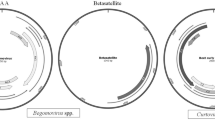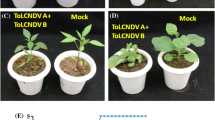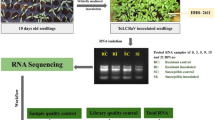Abstract
Southern tomato virus (STV) is often found infecting healthy tomato plants (Solanum lycopersicum). In this study, we compared STV-free and STV-infected plants of cultivar M82 to determine the effect of STV infection on the host plant. STV-free plants exhibited a short and bushy phenotype, whereas STV-infected plants were taller. STV-infected plants produced more fruit than STV-free plants, and the germination rate of seeds from STV-infected plants was higher than that of seeds from STV-free plants. This phenotypic difference was also observed in progeny plants (siblings) derived from a single STV-infected plant in which the transmission rate of STV to progeny plants via the seeds was approximately 86%. These results suggest that the interaction between STV and host plants is mutualistic. Transcriptome analysis revealed that STV infection affects gene expression in the host plant and results in downregulation of genes involved in ethylene biosynthesis and signaling. STV-infected tomato plants might thus be artificially selected due to their superior traits as a crop.






Similar content being viewed by others
References
Natsuaki T, Yamashita S, Doi Y, Okuda S, Teranaka M (1983) Radish yellow edge virus, a seed-borne virus with double-stranded RNA, of a possible new group. Ann Phytopathol Soc Jpn 49:593–599. https://doi.org/10.3186/jjphytopath.49.593
Dodds JA, Morris TJ, Jordan RL (1984) Plant viral double-stranded RNA. Annu Rev Phytopathol 22:151–168. https://doi.org/10.1146/annurev.py.22.090184.001055
Boccardo G, Lisa V, Luisini E, Milne RG (1987) Cryptic plant viruses. Adv Virus Res 32:171–214. https://doi.org/10.1016/S0065-3527(08)60477-7
Brown GG, Finnegan PM (1989) RNA plasmids. Int Rev Cytol 117:1–56. https://doi.org/10.1016/S0074-7696(08)61333-9
Gibbs MJ, Koga R, Moriyama H, Pfeiffer P, Fukuhara T (2000) Phylogenetic analysis of some large double-stranded RNA replicons from plants suggests they evolved from a defective single-stranded RNA virus. J Gen Virol 81:227–233. https://doi.org/10.1099/0022-1317-81-1-227
Fukuhara T, Koga R, Aoki N, Yuki C, Yamamoto N, Oyama N, Udagawa T, Horiuchi H, Miyazaki S, Higashi Y, Takeshita M, Ikeda K, Arakawa M, Matsumoto N, Moriyama H (2006) The wide distribution of endornaviruses, large double-stranded RNA replicons with plasmid-like properties. Arch Virol 151:995–1002. https://doi.org/10.1007/s00705-005-0688-5
Roossinck MJ (2010) Lifestyles of plant viruses. Philos Trans R Soc B 365:1899–1905. https://doi.org/10.1098/rstb.2010.0057
Ghabrial SA, Nibert ML, Maiss E, Lesker T, Baker TS, Tao YJ (2012) Family Partitiviridae. In: King AMQ, Adams MJ, Carstens EB, Lefkowitz EJ (eds) Virus taxonomy: ninth report of the International Committee on Taxonomy of Viruses. Elsevier, San Diego, pp 523–534
Fukuhara T, Gibbs MJ (2012) Family Endornaviridae. In: King AMQ, Adams MJ, Carstens EB, Lefkowitz EJ (eds) Virus taxonomy: ninth report of the International Committee on Taxonomy of Viruses. Elsevier, San Diego, pp 519–521
Sabanadzovic S, Valverde RA, Brown JK, Martin RR, Tzanetakis IE (2009) Southern tomato virus: the link between the families Totiviridae and Partitiviridae. Virus Res 140:130–137. https://doi.org/10.1016/j.virusres.2008.11.018
Wickner RB, Ghabrial SA, Nibert ML, Patterson JL, Wang CC (2012) Family Totiviridae. In: King AMQ, Adams MJ, Carstens EB, Lefkowitz EJ (eds) Virus taxonomy: ninth report of the International Committee on Taxonomy of Viruses. Elsevier, San Diego, pp 639–650
Tzanetakis IE, Sabanadzovic S (2013) Establishment of the family Amalgaviridae, the genus Amalgavirus and inclusion of four species in the genus. https://talk.ictvonline.org/files/ictv_official_taxonomy_updates_since_the_8th_report/m/plant-official/4828
Krupovic M, Dolja VV, Koonin EV (2015) Plant viruses of the Amalgaviridae family evolved via recombination between viruses with double-stranded and negative-strand RNA genomes. Biol Direct 10:12. https://doi.org/10.1186/s13062-015-0047-8
Nibert ML, Pyle JD, Firth AE (2016) A +1 ribosomal frameshifting motif prevalent among plant amalgaviruses. Virology 498:201–208. https://doi.org/10.1016/j.virol.2016.07.002
Candresse T, Marais A, Faure C (2013) First report of Southern tomato virus on tomatoes in southwest France. Plant Dis 97:1124. https://doi.org/10.1094/PDIS-01-13-0017-PDN
Iacono G, Hernandez-Llopis D, Alfaro-Fernandez A, Davino M, Font M, Panno S, Galipenso L, Rubio L, Davino S (2015) First report of Southern tomato virus in tomato crops in Italy. New Dis Rep 32:27. https://doi.org/10.5197/j.2044-0588.2015.032.027
Padmanabhan C, Zheng Y, Li R, Sun SE, Zhang D, Liu Y, Fei Z, Ling KS (2015) Complete genome sequence of southern tomato virus identified in China using next-generation sequencing. Genome Announc 3:e01266–15. https://doi.org/10.1128/genomeA.01226-15
Padmanabhan C, Zheng Y, Li R, Fei Z, Ling KS (2015) Complete genome sequence of southern tomato virus naturally infecting tomatoes in Bangladesh. Genome Announc 3:e01522–15. https://doi.org/10.1128/genomeA.01522-15
Verbeek M, Dullemans A, Espino A, Botella M, Alfaro-Fernández A, Font M (2015) First report of Southern tomato virus in tomato in the Canary Islands, Spain. J Plant Pathol 97:392. https://doi.org/10.4454/JPP.V97I2.038
Elvira-González L, Puchades AV, Carpino C, Alfaro-Fernandez A, Font-San-Ambrosio MI, Rubio L, Galipienso L (2017) Fast detection of Southern tomato virus by one-step transcription loop-mediated isothermal amplification (RT-LAMP). J Virol Methods 241:11–14. https://doi.org/10.1016/j.jviromet.2016.12.004
Puchades AV, Carpino C, Alfaro-Fernandez A, Font-San-Ambrosio MI, Davino S, Guerri J, Rubio L, Galipienso L (2017) Detection of Southern tomato virus by molecular hybridization. Ann Appl Biol 171:172–178. https://doi.org/10.1111/aab.12367
Turco S, Golyaev V, Seguin J, Gilli C, Farinelli L, Boller T, Schumpp O, Pooggin MM (2018) Small RNA-omics for virome reconstruction and antiviral defense characterization in mixed infections of cultivated Solanum plants. Mol Plant Microbe Interact 31:707–723. https://doi.org/10.1094/MPMI-12-17-0301-R
Alcalá-Briseño RI, Coşkan S, Londoño MA, Polston JE (2017) Genome sequence of Southern tomato virus in asymptomatic tomato ‘Sweet Hearts’. Genome Announc 5:e01374–16. https://doi.org/10.1128/genomeA.01374-16
Menda N, Semel Y, Peled D, Eshed Y, Zamir D (2004) In silico screening of a saturated mutation library of tomato. Plant J 38:861–872. https://doi.org/10.1111/j.1365-313X.2004.02088.x
Galpaz N, Wang O, Menda N, Zamir D, Hirschberg J (2008) Abscisic acid deficiency in the tomato mutant high pigment 3 leading to increased plastid number and higher fruit lycopene content. Plant J 53:717–730. https://doi.org/10.1111/j.1365-313X.2007.03362.x
Morris TJ, Dodds JA (1979) Isolation and analysis of double-stranded RNA from virus-infected plant and fungal tissue. Phytopathology 69:854–858. https://doi.org/10.1094/Phyto-69-854
Okada R, Kiyota E, Moriyama H, Fukuhara T, Natsuaki T (2015) A simple and rapid method for viral dsRNA isolation from plant and fungal tissue. J Gen Plant Pathol 81:103–107. https://doi.org/10.1007/s10327-014-0575-6
Langmead B, Salzberg S (2012) Fast gapped-read alignment with Bowtie 2. Nat Methods 9:357–359. https://doi.org/10.1038/nmeth.1923
Trapnell C, Roberts A, Goff L, Pertea G, Kim D, Kelley DR, Pimentel H, Salzberg SL, Rinn JL, Pachter L (2012) Differential gene and transcript expression analysis of RNA-seq experiments with TopHat and Cufflinks. Nat Protoc 7:562–578. https://doi.org/10.1038/nprot.2012.016
Shivaprasad PV, Dunn RM, Santos BA, Bassett A, Baulcombe DC (2012) Extraordinary transgressive phenotypes of hybrid tomato are influenced by epigenetics and small silencing RNAs. EMBO J 31:257–266. https://doi.org/10.1038/emboj.2011.458
Martin M (2011) Cutadapt removes adapter sequences from high-throughput sequencing reads. EMBnet J 17:10–12. https://doi.org/10.14806/ej.17.1.200
Robinson JT, Thorvaldsdóttir H, Winckler W, Guttman M, Lander ES, Getz G, Mesirov JP (2011) Integrative genomics viewer. Nat Biotechnol 29:24–26. https://doi.org/10.1038/nbt.1754
Wu HJ, Ma YK, Chen T, Wang M, Wang XJ (2012) PsRobot: a web-based plant small RNA meta-analysis toolbox. Nucleic Acids Res 40:W22–W28. https://doi.org/10.1093/nar/gks554
Xu P, Chen F, Mannas JP, Feldman T, Sumner LW, Roossinck MJ (2008) Virus infection improves drought tolerance. New Phytol 180:911–921. https://doi.org/10.1111/j.1469-8137.2008.02627.x
Westwood JH, McCann L, Naish M, Dixon H, Murphy AM, Stancombe MA, Bennett MH, Powell G, Webb AA, Carr JP (2013) A viral RNA silencing suppressor interferes with abscisic acid-mediated signalling and induces drought tolerance in Arabidopsis thaliana. Mol Plant Pathol 14:158–170. https://doi.org/10.1111/j.1364-3703.2012.00840.x
Abeles S, Morgan PW, Saltveit ME (1992) Ethylene in plant biology, 2nd edn. Academic Press, San Diego. https://doi.org/10.1016/C2009-0-03226-7
Smalle J, Van Der Straeten D (1997) Ethylene and vegetative development. Physiol Plant 100:593–605. https://doi.org/10.1111/j.1399-3054.1997.tb03065.x
Jafari Z, Haddad R, Hosseini R, Garoosi G (2013) Cloning, identification and expression analysis of ACC oxidase gene involved in ethylene production pathway. Mol Biol Rep 40:1341–1350. https://doi.org/10.1007/s11033-012-2178-7
Meng C, Yang D, Ma X, Zhao W, Liang X, Ma N, Meng Q (2016) Suppression of tomato SlNAC1 transcription factor delays fruit ripening. J Plant Physiol 193:88–96. https://doi.org/10.1016/j.jplph.2016.01.014
Zhang H, Zhang D, Chen J, Yang Y, Huang Z, Huang D, Wang XC, Huang R (2004) Tomato stress-responsive factor TSRF1 interacts with ethylene responsive element GCC box and regulates pathogen resistance to Ralstonia solanacearum. Plant Mol Biol 55:825–834. https://doi.org/10.1007/s11103-004-2140-8
Donaire L, Wang Y, Gonzalez-Ibeas D, Mayer KF, Aranda MA, Llave C (2009) Deep-sequencing of plant viral small RNAs reveals effective and widespread targeting of viral genomes. Virology 392:203–214. https://doi.org/10.1016/j.virol.2009.07.005
Ramesh SV, Williams S, Kappagantu M, Mitter N, Pappu HR (2017) Transcriptome-wide identification of host genes targeted by tomato spotted wilt virus-derived small interfering RNAs. Virus Res 238:13–23. https://doi.org/10.1016/j.virusres.2017.05.014
Mi S, Cai T, Hu Y, Chen Y, Hodges E, Ni F, Wu L, Li S, Zhou H, Long C, Chen S, Hannon GJ, Qi Y (2008) Sorting of small RNAs into Arabidopsis argonaute complexes is directed by the 5’ terminal nucleotide. Cell 133:116–127. https://doi.org/10.1016/j.cell.2008.02.034
Müller M, Munné-Bosch S (2015) Ethylene response factors: a key regulatory hub in hormone and stress signaling. Plant Physiol 169:32–41. https://doi.org/10.1104/pp.15.00677
Roossinck MJ (2011) The good viruses: viral mutualistic symbioses. Nat Rev Microbiol 9:99–108. https://doi.org/10.1038/nrmicro2491
Khankhum S, Valverde RA (2018) Physiological traits of endornavirus-infected and endornavirus-free common bean (Phaseolus vulgaris) cv Black Turtle Soup. Arch Virol 163:1051–1056. https://doi.org/10.1007/s00705-018-3702-4
Xie WS, Antoniw JF, White RF, Jolliffee TH (1994) Effects of beet cryptic virus infection on sugar beet in field trials. Ann Appl Biol 124:451–459. https://doi.org/10.1111/j.1744-7348.1994.tb04150.x
Kieber JJ, Rothenberg M, Roman G, Feldmann KA, Ecker JR (1993) Ctr1, a negative regulator of the ethylene response pathway in Arabidopsis, encodes a member of the Raf family of protein kinases. Cell 72:427–441. https://doi.org/10.1016/0092-8674(93)90119-B
Khankhum S, Sela N, Osorno JM, Valverde RA (2016) RNAseq analysis of endornavirus-infected vs. endornavirus-free common bean (Phaseolus vulgaris) cultivar Black Turtle Soup. Front Microbiol 7:1905. https://doi.org/10.3389/fmicb.2016.01905
Moriyama H, Horiuchi H, Koga R, Fukuhara T (1999) Molecular characterization of two endogenous double-stranded RNAs in rice and their inheritance by interspecific hybrids. J Biol Chem 274:6882–6888. https://doi.org/10.1074/jbc.274.11.6882
Read AF (1994) The evolution of virulence. Trends Microbiol 2:73–76. https://doi.org/10.1016/0966-842X(94)90537-1
Roossinck MJ (2015) Plants, viruses and the environment: ecology and mutualism. Virology 479–480:271–277. https://doi.org/10.1016/j.virol.2015.03.041
Acknowledgements
We thank Dr. Tomohide Natsuaki, Utsunomiya University, for valuable discussions, and the National BioResource Project of Japan, Tsukuba University, for providing tomato seeds. We acknowledge support received from the Gene Research Center at Tokyo University of Agriculture and Technology, the NGS core facility of the Genome Information Research Center at the Research Institute for Microbial Diseases of Osaka University, and the Human Genome Center at the Institute of Medical Science of the University of Tokyo.
Author information
Authors and Affiliations
Corresponding author
Ethics declarations
Conflict of interest
The authors declare that they have no conflicts of interest.
Funding
This work was supported by the Ministry of Education, Culture, Sports, Science and Technology (MEXT) of Japan (Scientific Research on Innovative Areas [nos. 16H06435, 16H06429, and 16H21723] to T.F. and H.T.) and the Global Innovation Research Organization of Tokyo University of Agriculture and Technology (to T.F.), and the Japan Society for the Promotion of Science (JSPS) through the JSPS Core-to-Core Program (Advanced Research Networks) entitled “Establishment of international agricultural immunology research-core for a quantum improvement in food safety” (to H.T.).
Additional information
Handling Editor: Jesús Navas-Castillo.
Publisher's Note
Springer Nature remains neutral with regard to jurisdictional claims in published maps and institutional affiliations.
Electronic supplementary material
Below is the link to the electronic supplementary material.
Rights and permissions
About this article
Cite this article
Fukuhara, T., Tabara, M., Koiwa, H. et al. Effect of asymptomatic infection with southern tomato virus on tomato plants. Arch Virol 165, 11–20 (2020). https://doi.org/10.1007/s00705-019-04436-1
Received:
Accepted:
Published:
Issue Date:
DOI: https://doi.org/10.1007/s00705-019-04436-1




